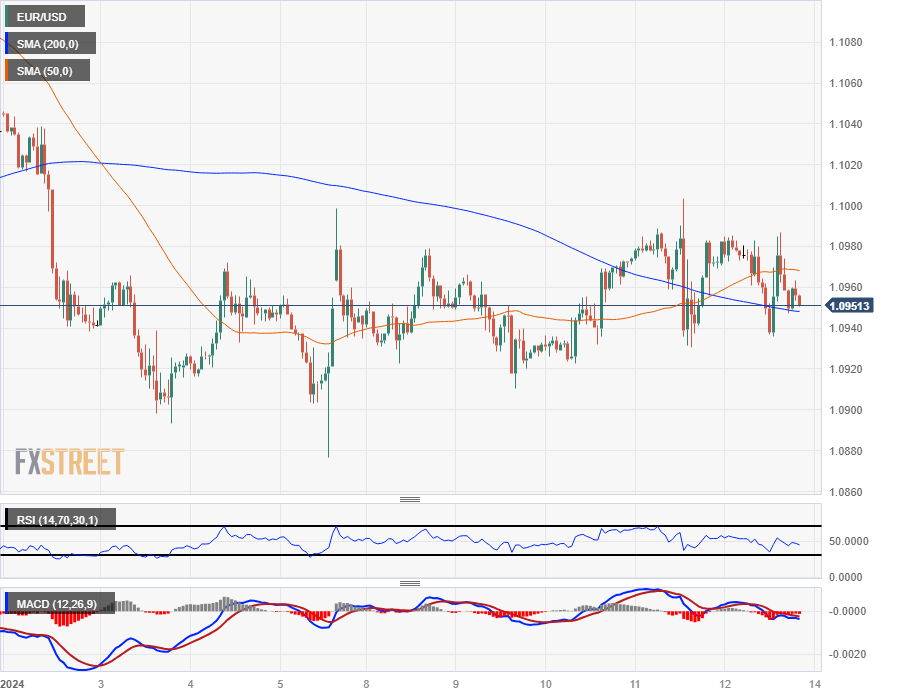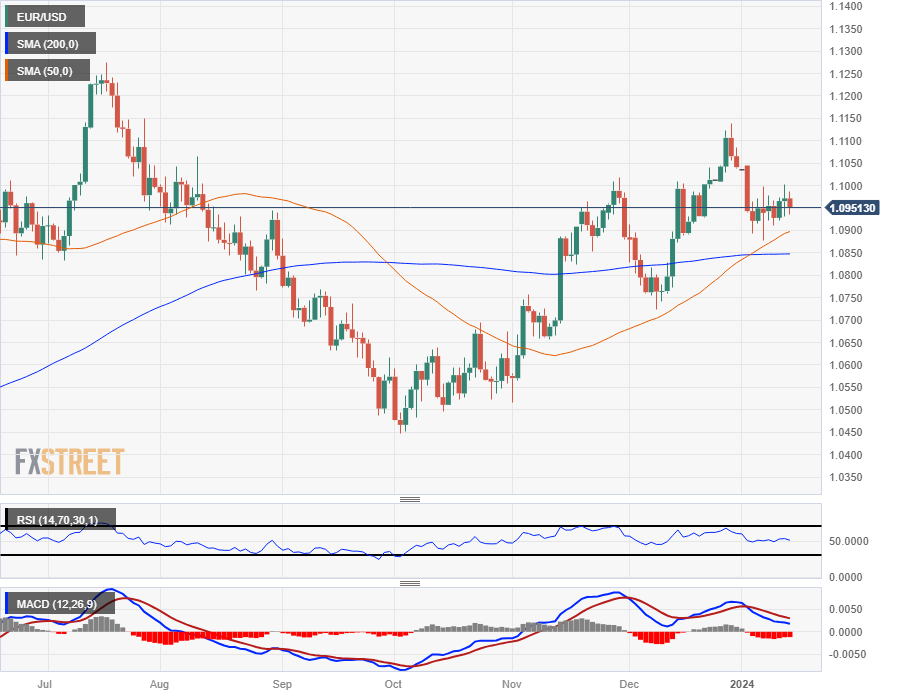- Euro struggles to gain momentum on Friday, pares back week’s performance.
- A slew of ECB talking points this week have bid down rate cut hopes.
- Next week’s economic calendar is light on eurozone data.
The Euro (EUR) is softening on Friday, backsliding against the majority of its major currency peers as dovish talking points from the European Central Bank (ECB) weigh on rate cut hopes. Next week sees limited eurozone data releases, with mid-tier Industrial Production and final Harmonized Index of Consumer Prices (HICP) due in the first half of the week.
A consensus miss on the US Producer Price Index (PPI) is the driving headlines on Friday as producer-level inflation recedes faster than expected. Slumping producer inflation kicked market expectations of Fed rate cuts into overdrive heading into the week’s final trading hours.
Daily digest market movers: Euro broadly weaker in Friday trading amidst dour outlook
- The Euro is down against most of the major currency bloc on Friday, declining 0.15% against the US Dollar (USD).
- ECB's President Lagarde: Rates have probably reached peak, EU not in recession.
- Multiple ECB officials have hit the wires this week, easing back market hopes of rate cuts.
- The ECB’s Economic Bulletin begrudgingly admitted the eurozone was in a “technical recession” with a soft landing scenario all but guaranteed.
- US annual PPI inflation rises to 1% in December vs. 1.3% expected.
- MoM US PPI in December held at -0.1%, in-line with November’s -0.1% (revised downward from 0.0%), missing the market forecast of 0.1% growth.
- Annualized core PPI also missed the mark, declining to 1.8% from November’s YoY figure of 2.0% and coming in below the median market forecast of 1.9%.
- Easing PPI inflation sparked a pop in Federal Reserve (Fed) rate cut expectations.
- Markets once again see 160 basis points in Fed rate cuts through 2024, up from 154 bps.
Euro price this week
The table below shows the percentage change of Euro (EUR) against listed major currencies this week. Euro was the strongest against the Australian Dollar.
| USD | EUR | GBP | CAD | AUD | JPY | NZD | CHF | |
| USD | -0.09% | -0.23% | 0.35% | 0.49% | 0.11% | 0.10% | 0.20% | |
| EUR | 0.08% | -0.15% | 0.44% | 0.57% | 0.19% | 0.19% | 0.25% | |
| GBP | 0.23% | 0.14% | 0.60% | 0.72% | 0.35% | 0.34% | 0.43% | |
| CAD | -0.35% | -0.43% | -0.57% | 0.14% | -0.23% | -0.25% | -0.18% | |
| AUD | -0.49% | -0.57% | -0.72% | -0.14% | -0.37% | -0.39% | -0.31% | |
| JPY | -0.12% | -0.18% | -0.34% | 0.27% | 0.40% | 0.01% | 0.09% | |
| NZD | -0.09% | -0.20% | -0.33% | 0.26% | 0.39% | 0.01% | 0.10% | |
| CHF | -0.19% | -0.25% | -0.40% | 0.19% | 0.33% | -0.06% | -0.06% |
The heat map shows percentage changes of major currencies against each other. The base currency is picked from the left column, while the quote currency is picked from the top row. For example, if you pick the Euro from the left column and move along the horizontal line to the Japanese Yen, the percentage change displayed in the box will represent EUR (base)/JPY (quote).
Technical Analysis: EUR/USD lower on Friday in chunky trading
The EUR/USD kicked off Friday’s trading near 1.0980, going back and forth in a rough intraday range as the pair grapples with bids near 1.0950. Intraday action continues to get hamstrung on the 200-hour Simple Moving Average (SMA). Near-term chart action is getting drawn into the midrange as the Fiber churns in rough consolidation.
According to daily candles, the pair is doing well, up nearly 5% from October’s bottom bids near 1.0450. Despite a pullback toward the 200-day SMA, a bullish cross of the 50-day and 200-day SMAs is building out a near-term price floor around 1.0900.
Continued selling pressure will drive the Fiber back into the long-term 200-day SMA near 1.0850. The challenge will be to drag the EUR/USD down to the last swing low near 1.0750. Bidders will be looking for topside momentum to carry the pair back into late December’s swing high near 1.1150.
EUR/USD Hourly Chart
EUR/USD Daily Chart
Euro FAQs
What is the Euro?
The Euro is the currency for the 20 European Union countries that belong to the Eurozone. It is the second most heavily traded currency in the world behind the US Dollar. In 2022, it accounted for 31% of all foreign exchange transactions, with an average daily turnover of over $2.2 trillion a day.
EUR/USD is the most heavily traded currency pair in the world, accounting for an estimated 30% off all transactions, followed by EUR/JPY (4%), EUR/GBP (3%) and EUR/AUD (2%).
What is the ECB and how does it impact the Euro?
The European Central Bank (ECB) in Frankfurt, Germany, is the reserve bank for the Eurozone. The ECB sets interest rates and manages monetary policy.
The ECB’s primary mandate is to maintain price stability, which means either controlling inflation or stimulating growth. Its primary tool is the raising or lowering of interest rates. Relatively high interest rates – or the expectation of higher rates – will usually benefit the Euro and vice versa.
The ECB Governing Council makes monetary policy decisions at meetings held eight times a year. Decisions are made by heads of the Eurozone national banks and six permanent members, including the President of the ECB, Christine Lagarde.
How does inflation data impact the value of the Euro?
Eurozone inflation data, measured by the Harmonized Index of Consumer Prices (HICP), is an important econometric for the Euro. If inflation rises more than expected, especially if above the ECB’s 2% target, it obliges the ECB to raise interest rates to bring it back under control.
Relatively high interest rates compared to its counterparts will usually benefit the Euro, as it makes the region more attractive as a place for global investors to park their money.
How does economic data influence the value of the Euro?
Data releases gauge the health of the economy and can impact on the Euro. Indicators such as GDP, Manufacturing and Services PMIs, employment, and consumer sentiment surveys can all influence the direction of the single currency.
A strong economy is good for the Euro. Not only does it attract more foreign investment but it may encourage the ECB to put up interest rates, which will directly strengthen the Euro. Otherwise, if economic data is weak, the Euro is likely to fall.
Economic data for the four largest economies in the euro area (Germany, France, Italy and Spain) are especially significant, as they account for 75% of the Eurozone’s economy.
How does the Trade Balance impact the Euro?
Another significant data release for the Euro is the Trade Balance. This indicator measures the difference between what a country earns from its exports and what it spends on imports over a given period.
If a country produces highly sought after exports then its currency will gain in value purely from the extra demand created from foreign buyers seeking to purchase these goods. Therefore, a positive net Trade Balance strengthens a currency and vice versa for a negative balance.
Information on these pages contains forward-looking statements that involve risks and uncertainties. Markets and instruments profiled on this page are for informational purposes only and should not in any way come across as a recommendation to buy or sell in these assets. You should do your own thorough research before making any investment decisions. FXStreet does not in any way guarantee that this information is free from mistakes, errors, or material misstatements. It also does not guarantee that this information is of a timely nature. Investing in Open Markets involves a great deal of risk, including the loss of all or a portion of your investment, as well as emotional distress. All risks, losses and costs associated with investing, including total loss of principal, are your responsibility. The views and opinions expressed in this article are those of the authors and do not necessarily reflect the official policy or position of FXStreet nor its advertisers. The author will not be held responsible for information that is found at the end of links posted on this page.
If not otherwise explicitly mentioned in the body of the article, at the time of writing, the author has no position in any stock mentioned in this article and no business relationship with any company mentioned. The author has not received compensation for writing this article, other than from FXStreet.
FXStreet and the author do not provide personalized recommendations. The author makes no representations as to the accuracy, completeness, or suitability of this information. FXStreet and the author will not be liable for any errors, omissions or any losses, injuries or damages arising from this information and its display or use. Errors and omissions excepted.
The author and FXStreet are not registered investment advisors and nothing in this article is intended to be investment advice.
Recommended content
Editors’ Picks

EUR/USD extends recovery beyond 1.0400 amid Wall Street's turnaround
EUR/USD extends its recovery beyond 1.0400, helped by the better performance of Wall Street and softer-than-anticipated United States PCE inflation. Profit-taking ahead of the winter holidays also takes its toll.

GBP/USD nears 1.2600 on renewed USD weakness
GBP/USD extends its rebound from multi-month lows and approaches 1.2600. The US Dollar stays on the back foot after softer-than-expected PCE inflation data, helping the pair edge higher. Nevertheless, GBP/USD remains on track to end the week in negative territory.

Gold rises above $2,620 as US yields edge lower
Gold extends its daily rebound and trades above $2,620 on Friday. The benchmark 10-year US Treasury bond yield declines toward 4.5% following the PCE inflation data for November, helping XAU/USD stretch higher in the American session.

Bitcoin crashes to $96,000, altcoins bleed: Top trades for sidelined buyers
Bitcoin (BTC) slipped under the $100,000 milestone and touched the $96,000 level briefly on Friday, a sharp decline that has also hit hard prices of other altcoins and particularly meme coins.

Bank of England stays on hold, but a dovish front is building
Bank of England rates were maintained at 4.75% today, in line with expectations. However, the 6-3 vote split sent a moderately dovish signal to markets, prompting some dovish repricing and a weaker pound. We remain more dovish than market pricing for 2025.

Best Forex Brokers with Low Spreads
VERIFIED Low spreads are crucial for reducing trading costs. Explore top Forex brokers offering competitive spreads and high leverage. Compare options for EUR/USD, GBP/USD, USD/JPY, and Gold.